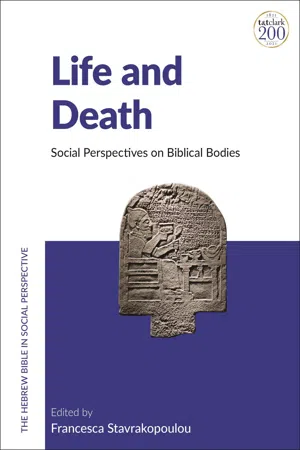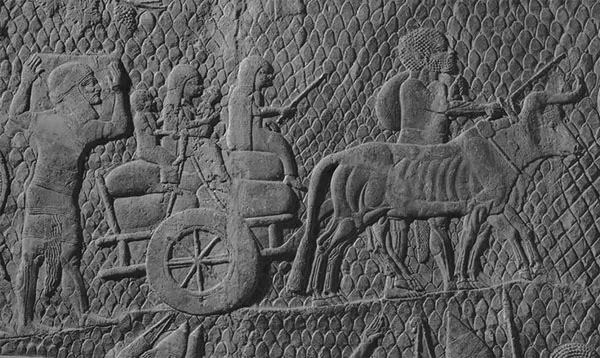
eBook - ePub
Life and Death
Social Perspectives on Biblical Bodies
This is a test
- 224 pages
- English
- ePUB (mobile friendly)
- Available on iOS & Android
eBook - ePub
Life and Death
Social Perspectives on Biblical Bodies
Book details
Book preview
Table of contents
Citations
About This Book
Life and Death: Social Perspectives on Biblical Bodies explores some of the social, material, and ideological dynamics shaping life and death in both the Hebrew Bible and ancient Israel and Judah. Analysing topics ranging from the bodily realities of gestation, subsistence, and death, and embodied performances of gender, power, and status, to the imagined realities of post-mortem and divine existence, the essays in this volume offer exciting new trajectories in our understanding of the ways in which embodiment played out in the societies in which the texts of the Hebrew Bible emerged.
Frequently asked questions
At the moment all of our mobile-responsive ePub books are available to download via the app. Most of our PDFs are also available to download and we're working on making the final remaining ones downloadable now. Learn more here.
Both plans give you full access to the library and all of Perlego’s features. The only differences are the price and subscription period: With the annual plan you’ll save around 30% compared to 12 months on the monthly plan.
We are an online textbook subscription service, where you can get access to an entire online library for less than the price of a single book per month. With over 1 million books across 1000+ topics, we’ve got you covered! Learn more here.
Look out for the read-aloud symbol on your next book to see if you can listen to it. The read-aloud tool reads text aloud for you, highlighting the text as it is being read. You can pause it, speed it up and slow it down. Learn more here.
Yes, you can access Life and Death by Francesca Stavrakopoulou, Francesca Stavrakopoulou in PDF and/or ePUB format, as well as other popular books in Theology & Religion & Biblical Studies. We have over one million books available in our catalogue for you to explore.
Information
CHAPTER ONE
The materiality of life and the sociality of death: An introduction
FRANCESCA STAVRAKOPOULOU
Families file out of the city, their belongings bundled into bags on their backs or stacked high on ox-drawn carts. Small children toddle alongside their parents, some hanging onto their mother’s skirts, others clutching their father’s legs. Those too young or too tired to walk are carried on adults’ shoulders. The women and children of one household are squeezed into a cart, balanced on their baggage; one woman cradles an infant on her lap, while the arms of an older child sitting behind her are clasped around her waist. Ahead of them is a man, perhaps a member of the same household, walking alongside the oxen, using a slender stick to keep the animals on course; behind the wagon is another male figure, carrying a heavy load on his back. Just one group among many, the motley procession makes its way across the mountainous landscape, past trees and vines heavy with fruit. But this is no liberating exodus. Soldiers flank the families deserting the battered city, marching the long line of men, women, children and animals past impaled bodies and corpses stretched out for flaying. On they go across the rugged landscape, towards their own particular fate: incorporation into Assyria. The supreme power of the empire is embodied by King Sennacherib himself, who sits upon a lofty throne, upheld by divine beings, overseeing the sack of the city and the parade of the spoils of war (see Figures 1.1–1.6).1
It is fitting to begin a book about bodies in the Hebrew Bible with an iconographic portrayal of some of those who lived and died in the world in which the biblical texts emerged. The Lachish reliefs of Nineveh’s Southwest Palace are frequently held to be the closest we can come to a snapshot of the people of ancient Judah. Commissioned by Sennacherib as part of a series celebrating his subjugation of far-flung territories (Russell 1991, 1994; Barnett, Bleibtreu and Turner 1998; Lippolis 2011), the vast gypsum wall panels excavated from room XXXVI of the palace (Layard 1853) depict the Assyrian attack on Judah’s second city in 701 BCE (Ussishkin 1982, 2003, 2014a, 2014b). Although the beleaguered citizens of Lachish feature only as bit-players in this visual drama, the reliefs have become a prominent touchstone in wider analyses of the social and material realities of Iron II Judahite culture. Encouraged by archaeological and topographical studies of the site of ancient Lachish (Tell ed-Duweir), which are argued to corroborate the iconographic portrayal of the city’s siege, there is a scholarly tendency to cast the reliefs as realistic rather than schematic reflections of the battle and its aftermath, based, perhaps, on sketches produced by on-site Assyrian artists (Ussishkin 1982: 119, 126; Dever 2012: 356) or the eyewitness testimonies of those who experienced the campaign (Russell 1991: 208–9; cf. Barnett 1958).2 Dazzling in their detail, these stone artworks thus appear to offer us images of the ‘real’ people of the ‘biblical’ past, inviting us to scrutinize their physical appearance, their belongings, their animals and their city for evidence of the social, material and ideological dynamics shaping Judahite and (by extension) Israelite life.3
These are the social and cultural dynamics with which this book is concerned. Scholars have long understood that human bodies are far from ‘neutral’ sites of sociocultural significance. Rather, our bodies are the material places at which various identities and differences (such as gender, status, sexuality or ethnicity) are constructed, communicated and negotiated (Shilling 2003; Mascia-Lees 2011; Turner 2012; Robb and Harris 2013). From the foods we eat and the ways we dress, to the activities we undertake to deal with the dead or imagine other-worldly beings, our bodies manifest the ways in which we relate to those within and beyond the various social groups into which we are incorporated. Just as bodilyness is inherently social, so sociality is inextricably bodily and material (Lambert and McDonald 2009; Attala and Steel 2019), encoding our bodies as the very sites at and by which personhood – what it is to be socially recognized as a ‘person’ – is constituted (Fowler 2004, 2010; Appell-Warren 2014; McIntosh 2018). But the body is more than a static symbol or passive marker of sociality and personhood. The very materiality and malleability of our bodies render them unfixed and unstable sites of identity and difference, for our bodies are continuously and recursively brought into ‘being’ by means of social relations, material practices and cultural performances (see Stavrakopoulou 2013, and the literature cited there). The chapters in this book – detailed further below – explore some of the ways in which bodily sociality operated in the world giving rise to the Hebrew Bible. By way of introduction, closer consideration of selected scenes from the Lachish reliefs can help to contextualize some of the issues explored in subsequent chapters.
Among the displaced citizens on the reliefs, for example, different social groups are distinguished in terms of gender and age by their clothing and hair: men are bearded, and wear soft caps with prominent ear flaps, and short tunics accessorized with thick belts and dangling sashes. By contrast, women wear plain, loose-fitting, ankle-length tunics and long hooded cloaks, covering their hair. Children, too, are gendered by their dress. The girls wear mini-versions of adult female clothing, including long head coverings, while the boys are dressed in short belted tunics (Figures 1.1 and 1.2). Unlike the girls, who are imaged simply as smaller versions of grown women, the boys’ younger age in relation to men seems to be signalled by their thinner belts, close-cropped hair or skull caps, and an absence of sashes (Albenda 1983; Garroway 2020; Riley 2020).

FIGURE 1.1: Citizens leaving Lachish, among them young girls (left) and small boys (right). BM 124908 (detail). Image courtesy of the British Museum.

FIGURE 1.2: Women and children in an ox-drawn cart. Scene from the Lachish reliefs. BM 124908 (detail). Image courtesy of the British Museum.
As is now widely understood, the material manifestation of gender by means of dress and hair management (whether grooming, shaving or covering) is neither culturally incidental nor reductively reflexive of physiology. Rather, the use of clothing and hair practices to gender the body reflects and projects social processes of enculturation, which are themselves bound up with wider sociocultural preferences about the ways in which people’s bodies variously mediate and negotiate identity and difference, status and role, and notions of personhood. In this way, the ‘dressed’ body is a body modified, so that differences in clothing and hairstyle, including the covering or uncovering of certain body parts by means of textiles or hair, might serve to ‘make’ and ‘remake’ bodies and mark their social differences, both in everyday life and in more specialized or temporary circumstances (Cifarelli and Gawlinksi 2017; Han and Antrosio 2018; Cifarelli 2019).
Something of the enculturation of gender can be seen on the Lachish reliefs. Here, the infancy of a cradled child (Figures 1.2 and 1.3) is signalled not only by its long sidelock – a relatively common motif in the iconography of young children in ancient Southwest Asia – but also by its nakedness, rendering its gendered identity as a ‘boy’ or a ‘girl’ seemingly unmarked (Schwyn 2000, 2006; Garroway 2020; Riley 2020; cf. Garroway 2012).4 This is not to suggest, however, that the child is ungendered. Rather, the infant’s nudity is suggestive of a form of ‘non-binary’ gender – a designation which is not without its problems, but serves here as an umbrella term for a range of ancient-world gender constructs which might also encompass intersex persons (both mortal and divine) and those of composite, intersectional, transitional, multiple, fluid, ambiguous or modified genders, including those persons conventionally termed ‘eunuchs’ (Peled 2016; Asher-Greve 2018; Green...
Table of contents
- Cover
- Series Page
- Title Page
- Contents
- Figures
- Contributors
- Editor’s Note
- Abbreviations
- Chapter One The materiality of life and the sociality of death: An introduction
- Part One Praxis and materiality
- Part Two Value, status and power
- Part Three Extended sociality
- Index of Ancient Sources
- Index of Authors
- Index of Subjects
- Copyright Page